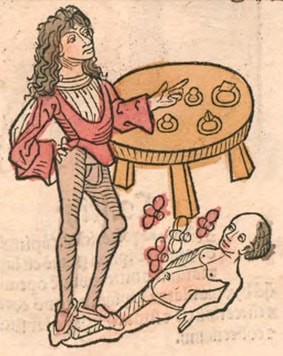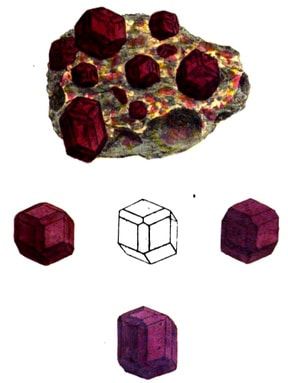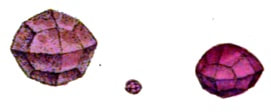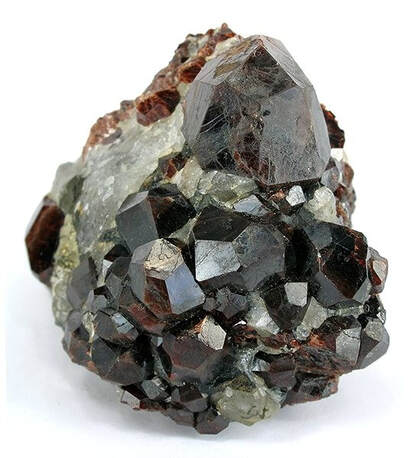Sentry Page Protection
Granatum, Garnet
Carbunculus (also used for other red gems)
Cinnamon stone (Hessonite)
Gomed (Hessonite, Ayurveda)
Cinnamon stone (Hessonite)
Gomed (Hessonite, Ayurveda)
Ortus Sanitatis, 1491
Mineralogical name:
The Garnet family is complex and is divided into various types:
1. Aluminium Garnets:
Pyrope (Red, Violet, to Black and Green): Mg3Al2(SiO4)3
Grossularite (White, Yellow, Green, Red, Orange or Black): Ca3Al2(SiO4)3
Hessonite (Orange-red): Ca3Al2(SiO4)3
Spessarite (Yellow, Rose): Mn3Al2(SiO4)3
Almandine (Violet-red, Brown or Black colored): Fe3Al2(SiO4)3
2. Ferrous Garnets:
Andradite: Ca3Fe23+(SiO4)3; (green, yellow, black/brown)
Majorite: Mg3(Fe, Si)2(SiO4)3
Calderite: Mn3Fe2(SiO4)3
Skiagite: Fe32+Fe23+(SiO4)3
3. Chromium Garnets:
Uvarovite (Green to Emerald Green): Ca3Cr2(SiO4)3
Knorringite: (Ca, Mg)3Cr2(SiO4)3
4. Vanadium Garnets:
Goldmanite: Ca3V23+(SiO4)3
Yamatoite: Mn3V2(SiO4)3
5. Zirconium Garnets:
Kimzeyite: Ca3Zr2Al2SiO12
Parts used:
Red to Red-Brown Garnets including Hessonite, Pyrope and Almandine (princiapally Aluminium Garnets).
‘A shining transparent Gem, of a Yellow Red, almost like fire or Minium, being a kind of Hyacinth, and is either Oriental or Occidental: the first are brought to us out of Ethiopia, the other from Spain and Silesia. The Oriental are best, but the shops have none but the Occidental’ (Salmon)
Hessonite is the type most often used in India.
According to Ayurveda, the Black variety is beneficial in medicine, the white type is used in the Alchemical manufacture of Silver, the Yellow being used for the manufacture of Gold, and the red variety has all round use. Blue and ‘Pigeon-colored’ types are not used (said to be abortive).
Temperature & Taste:
Cool, dry. Sweet, Salty
Properties:
Nature: Crystalline; in the forms of hexaoctahedra and rhombododecahedra
Color: Reddish-brown
Streak: White
Cleavage: none
Fracture: Sub-conchoidal
Lustre: Vitreous to resinous
Tenacity: Brittle
Transparency: Translucent
Hardness: 7–7.5
Specific Gravity: 3.5–4
All except Andradite are soluble in acids.
Constituents:
Almandine: iron aluminum silicate (Fe3Al2(SiO4)3)
Hessonite: Calcium aluminium silicate (Ca3Al2(SiO4)3)
Pyrope: magnesium aluminum silicate (Mg3Al2(SiO4)3)
Garnets are said to contain a little of most metals, the most common being Mg, Fe, Ca, Al, Cr, Mn, Ti, Zr and Y.
The Garnet family is complex and is divided into various types:
1. Aluminium Garnets:
Pyrope (Red, Violet, to Black and Green): Mg3Al2(SiO4)3
Grossularite (White, Yellow, Green, Red, Orange or Black): Ca3Al2(SiO4)3
Hessonite (Orange-red): Ca3Al2(SiO4)3
Spessarite (Yellow, Rose): Mn3Al2(SiO4)3
Almandine (Violet-red, Brown or Black colored): Fe3Al2(SiO4)3
2. Ferrous Garnets:
Andradite: Ca3Fe23+(SiO4)3; (green, yellow, black/brown)
Majorite: Mg3(Fe, Si)2(SiO4)3
Calderite: Mn3Fe2(SiO4)3
Skiagite: Fe32+Fe23+(SiO4)3
3. Chromium Garnets:
Uvarovite (Green to Emerald Green): Ca3Cr2(SiO4)3
Knorringite: (Ca, Mg)3Cr2(SiO4)3
4. Vanadium Garnets:
Goldmanite: Ca3V23+(SiO4)3
Yamatoite: Mn3V2(SiO4)3
5. Zirconium Garnets:
Kimzeyite: Ca3Zr2Al2SiO12
Parts used:
Red to Red-Brown Garnets including Hessonite, Pyrope and Almandine (princiapally Aluminium Garnets).
‘A shining transparent Gem, of a Yellow Red, almost like fire or Minium, being a kind of Hyacinth, and is either Oriental or Occidental: the first are brought to us out of Ethiopia, the other from Spain and Silesia. The Oriental are best, but the shops have none but the Occidental’ (Salmon)
Hessonite is the type most often used in India.
According to Ayurveda, the Black variety is beneficial in medicine, the white type is used in the Alchemical manufacture of Silver, the Yellow being used for the manufacture of Gold, and the red variety has all round use. Blue and ‘Pigeon-colored’ types are not used (said to be abortive).
Temperature & Taste:
Cool, dry. Sweet, Salty
Properties:
Nature: Crystalline; in the forms of hexaoctahedra and rhombododecahedra
Color: Reddish-brown
Streak: White
Cleavage: none
Fracture: Sub-conchoidal
Lustre: Vitreous to resinous
Tenacity: Brittle
Transparency: Translucent
Hardness: 7–7.5
Specific Gravity: 3.5–4
All except Andradite are soluble in acids.
Constituents:
Almandine: iron aluminum silicate (Fe3Al2(SiO4)3)
Hessonite: Calcium aluminium silicate (Ca3Al2(SiO4)3)
Pyrope: magnesium aluminum silicate (Mg3Al2(SiO4)3)
Garnets are said to contain a little of most metals, the most common being Mg, Fe, Ca, Al, Cr, Mn, Ti, Zr and Y.
Uses:
1. Clears Heat, Resists Poison:
-protects and treats Infectious and epidemic diseases including Plague
-Poison (Salmon)
-Fevers
2. Strengthens the Heart, Settles Wind, Calms the Spirit:
-Insomnia
-Palpitations, Tachycardia
-Melancholy (Salmon); ‘They resist Sadness’ (Culpeper)
-‘The Garnet raises the Spirits, and drives Melancholy away’ (Lexicon of Alchemy)
-Mental illness including Schizophrenia, Depression, Anxiety (Ayurveda)
-Epilepsy, Parslysis (Ayurveda)
-promotes positive thinking and improves concentration. (Ayurveda)
3. Nourishes Blood, Tonifies Yin (Ayurveda, Hessonite):
-Rasayana (tonic to the 7 body tissues)
-anemia, weakness, fatigue
-benefits skin and complexion
-wasting diseases, Tuberculosis
-promotes strength, intelligence and longevity
-some Ayurvedic texts claim it is useful in Cancer
-aphrodisiac
4. Stops Bleeding:
-Spitting of Blood (Salmon)
5. Clears Stones:
-break, dissolve and expel Urinary Stones (Salmon)
6. Externally:
-distilled, it is a most powerful salve for spots of the Eyes.
Preparation:
1. It may be heated and quenched a number of times before being levigated with rose water, sieved and dried for use. This is the Pishti form used in Ayurveda.
2. It may be burnt to form a Bhasma or dissolved with acids and precipitated as for other precious stones.
Dose:
Pishi (levigated powder) and Bhasma (calcined product can be used in similar doses for similar purposes. The Pishti is more cooling.
Levigated Powder: 60–125mg (up to 250mg), taken with Milk, Honey or Ghee.
Children can take 20–60mg
Magical Uses:
-'it does illuminate the Heart to contemplate true and divine things'. (The History of Precious Stones, Nicols, 1652)
-worn to protect from pestilential air, and epidemics, and remove negative or fearful thoughts
-as a charm to protect from lightning strikes
-worn to bring hope, happiness and a pleasant demeanor.
-increases Meditation, promotes Morality and Spiritual Growth, increases Wealth, balances Wordly pleasure and heads one to Nirvana. (Ayurveda)
-as with Ruby, it was said to become dull or dark and lose its lustre if the wearer was in danger.
Substitutes:
1. Garnets have been used as a substitute for Ruby
2. Red Spinel, Red Garnet, Reddish Zircon, Ruby and Carbuncle have all been used similarly and often substituted for one another.
3. According to Ayurvedic texts, the best Garnets have qualities similar to Diamond and may be substituted for them
1. It may be heated and quenched a number of times before being levigated with rose water, sieved and dried for use. This is the Pishti form used in Ayurveda.
2. It may be burnt to form a Bhasma or dissolved with acids and precipitated as for other precious stones.
Dose:
Pishi (levigated powder) and Bhasma (calcined product can be used in similar doses for similar purposes. The Pishti is more cooling.
Levigated Powder: 60–125mg (up to 250mg), taken with Milk, Honey or Ghee.
Children can take 20–60mg
Magical Uses:
-'it does illuminate the Heart to contemplate true and divine things'. (The History of Precious Stones, Nicols, 1652)
-worn to protect from pestilential air, and epidemics, and remove negative or fearful thoughts
-as a charm to protect from lightning strikes
-worn to bring hope, happiness and a pleasant demeanor.
-increases Meditation, promotes Morality and Spiritual Growth, increases Wealth, balances Wordly pleasure and heads one to Nirvana. (Ayurveda)
-as with Ruby, it was said to become dull or dark and lose its lustre if the wearer was in danger.
Substitutes:
1. Garnets have been used as a substitute for Ruby
2. Red Spinel, Red Garnet, Reddish Zircon, Ruby and Carbuncle have all been used similarly and often substituted for one another.
3. According to Ayurvedic texts, the best Garnets have qualities similar to Diamond and may be substituted for them
Main Combinations:
1. Calm the Heart and Mind, and for Palpitations, Garnet with Pearl, Coral, Rose
2. Heart Fire, Garnet, Borage, Balm, Rose, Sandalwood, Amber, Pearl, Tabsheer
3. Tachycardia, Hessonite Pishti, Pearl Pishti, Mica Bhasma (125mg each), Arjuna (500mg), Indian Spikenard (1000mg) (Ayurveda)
4. Fever, Spotted Fevers, Garnet, Pearl, Tabasheer, Rose, Sandalwood
5. Melancholy, Sadness or Fear without cause, Garnet, Pearl, Doronicum, Amber, Cinnamon, Saffron
6. Depression, Hessonite Pishti, Pearl, Licorice, Gotu Kola, Indian Spikenard, Convolvulus Shankhpushpi (Ayurveda)
7. Epilepsy, Hessonite Pishti, Mica Bhasma (125mg each), Indian Spikenard (1000mg); take twice daily. (Ayurveda)
Major Formulas:
Vigorous Cakes
Warming Powder of Gems (Mesue)
Cooling Powder of Gems
Cordial Powder
Powder to Cool the Heart
Letificans Conciliatoris
Electuary of Gems (Mesue)
Emperor’s Powder Against the Plague
Cautions:
1. Standard cautions for using Gem stones.
2. ‘Hurts the brain, causes Anger and takes away sleep’ (Culpeper)
Toxicity:
No ill effects have been noted in adults when 250mg doses have been administered daily for 3 months.
Main Preparations used:
Levigated powder; Bhasma; various other preparations.
1. Standard cautions for using Gem stones.
2. ‘Hurts the brain, causes Anger and takes away sleep’ (Culpeper)
Toxicity:
No ill effects have been noted in adults when 250mg doses have been administered daily for 3 months.
Main Preparations used:
Levigated powder; Bhasma; various other preparations.




